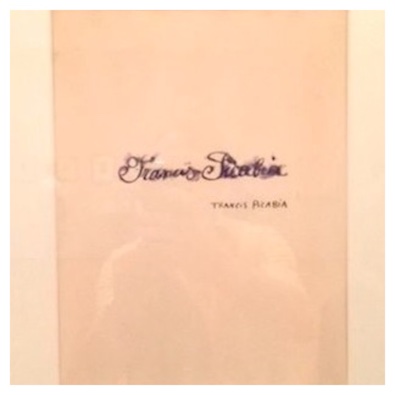
Photo: “Untitled Signature” by Francis Picabia
The year was 1915, when a thirty-six-year-old Francis Picabia showed up to the New York Dada scene. His alibi to leave Europe was a story about his travels to Cuba in order to purchase molasses, a story he cleverly forgot once he arrived in New York.
Picabia, like many of the Dadaists, sought exile from war-torn Europe in New York City and Zurich. In an apartment on West 67th Street, rounds of parties and gatherings created, according to Picabia’s first wife, Gabrièlle Buffet-Picabia, “an atmosphere entirely free from conventions and social prejudices.”
Picabia went on to challenge mechanization and how it threatened to turn men into robots, and satirized this concept in the piece, “Very Rare Picture upon the Earth”(1915). He even dabbled and worked on collages, his most memorable work being, “L'Oeil Cacodylate”, or “The Cacodylic Eye”(1921).
There is one piece of intrigue that has made its ways into frames hung up on museum walls and that is Francis Picabia’s “Untitled Signature” (pictured above), which is a fancifully cursive signature of Francis Picabia’s first and last name, with a smaller version of his name (in print) on the bottom-right corner. In the unconventional, convention of the Dada Movement, this piece brings attention to the purpose of the artist signature—a visible signature—in a work of art.
Webcomic creators make use of the signature in many forms. There are full-page visible watermarks stretched across the page, hidden signatures that blend into the backgrounds or character designs, and some comics where the creator’s signature combined a copyright symbol and year fits into the third panel. Francis Picabia picked up on the importance of the signature, likely by noticing how loosely the Impressionists used them in their works.
Signatures do little in the struggle of separating the art from the artist, they do the opposite. It is very humorous, an artist’s signature as the main focus of an artwork is a complete removal of the art from the artist.
.::.
What's Quacking?
Do you have any original art to contribute to our stock image database, announcements, community projects, ideas, news, or milestones to report? Please leave general comments below or send a PQ to kawaiidaigakusei. Email me at kawaiidaigakusei(at)gmail(dot)com.

Francis Picabia and the Art of the Signature
kawaiidaigakusei at 12:00AM, Feb. 21, 2022
5 likes!


©2011 WOWIO, Inc. All Rights Reserved Mastodon





PaulEberhardt at 1:20PM, Feb. 21, 2022
Dadaists thought of themselves as an anti-art movement, lampooning especially the pretentiousness they perceived in the artistic establishment. In a way they were the early 20th century's version of punk. Paradoxically, this kind of thing happening every now and again always benefits arts and music like nothing else. This said, I never considered signing my scribblings as trying to put myself forward, but rather as acknowledging them as my work, as in taking a polite bow to accept the applause (ideally) or, failing that, having at least the decency to stand up to the rotten eggs like a man. To me, not signing would mean chickening out - but feel free to disagree; there may be good reasons for not signing in some cases. I also put a year number under each of my signatures to keep track of my past misdeeds. :) Btw. I've always admired André Franquin's way of creatively using his signatures to have a bit of additional fun. I wish I could do that, but I've never come up with anything good.
Andreas_Helixfinger at 7:56AM, Feb. 21, 2022
That is the thing. I used to try to dissasociate myself from my stories only to end up associating with it more (Naming the planet my current stories take place on Helix🙄). And even before then I was incorporating my Helixfinger signature into the background, which come to think of it I haven't done for a good dozen pages or so now. I should really try to get it in there more often:P
MOrgan at 3:24AM, Feb. 21, 2022
There was (is?) an adult artist named Karsten who, instead of a signature, would use a unique background pattern. Back in the old dial-up days when pictures would start as a blurry image before becoming a clear, sharp picture, you could always tell when it was a Karsten pic because the shape of the background would be obvious.